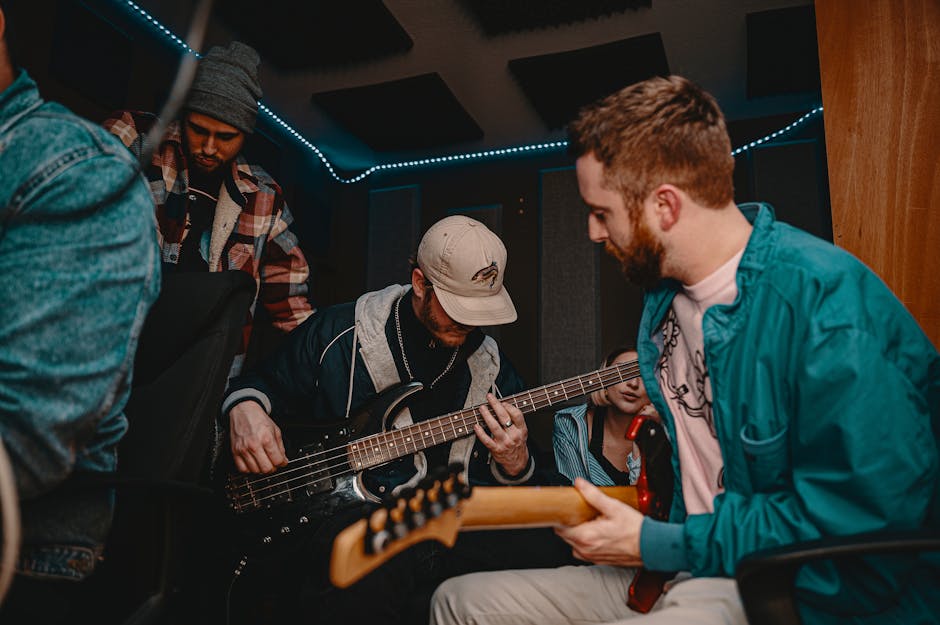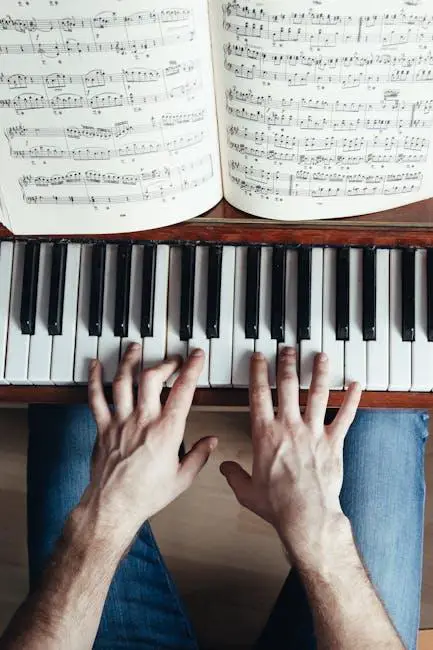Do you find yourself struggling to keep up with sheet music like a clumsy toddler navigating through a room covered in Lego blocks? Fear not, dear reader, for there is a magical and mystical skill known as playing by ear that can set you free from the shackles of traditional notation. Think of it as the musical equivalent of freestyling in a rap battle – except instead of spitting fire with words, you’re tickling the ivories or strumming the strings with reckless abandon. So buckle up, buttercup, as we embark on a wild and whimsical journey to mastering the art of playing by ear – where anything is possible and musical enlightenment awaits.
Contents
- 1 Understanding the Foundations of Playing by Ear
- 2 Developing Your Listening Skills for Musical Nuances
- 3 Training Your Hands to Follow What Your Ears Hear
- 4 Techniques for Transcribing Music Without Sheet Music
- 5 Overcoming Challenges in Playing by Ear
- 6 Expanding Your Musical Repertoire through Improvisation
- 7 Advancing Beyond Basics: Mastering Complex Harmonies and Rhythms
- 8 FAQs
- 9 Keep Jamming and Ear It Up!
Understanding the Foundations of Playing by Ear
So you’ve always been envious of those musicians who can just pick up an instrument and play any song by ear, huh? Well, fear not my friend, because I’m here to break down the foundations of playing by ear for you in a way that even your pet goldfish could understand!
First things first, let’s talk about the importance of really listening to the music. I’m not just talking about hearing the notes and rhythms, I mean REALLY listening. Like, shutting out all distractions, closing your eyes, and letting the notes wash over you like a gentle summer breeze. Trust me, it’s a lot easier to play by ear when you actually pay attention to what you’re hearing.
Next up, let’s chat about the magical powers of pattern recognition. Just like how your mom can recognize your footsteps from a mile away when you’re trying to sneak back into the house past curfew, your brain can start to pick up on the patterns and structures of different songs. Once you start to notice these patterns, playing by ear becomes as easy as stealing candy from a baby (not that I condone that…).
And last but not least, embrace the art of trial and error. Look, nobody becomes a master musician overnight. It takes practice, patience, and a whole lot of wrong notes. But hey, that’s all part of the fun! So don’t be afraid to experiment, make mistakes, and laugh at yourself when you accidentally play “Twinkle Twinkle Little Star” instead of that killer guitar solo you were aiming for. Remember, Rome wasn’t built in a day, and neither was your ability to play by ear!

Developing Your Listening Skills for Musical Nuances
So you think you’ve got what it takes to be a musical aficionado, huh? Well, buckle up because is no walk in the park. It’s like trying to solve a Rubik’s cube blindfolded while riding a unicycle – tricky, but not impossible!
First things first, learn to pay attention to the little details. Those subtle changes in tempo, dynamics, and phrasing can make all the difference in how a piece of music is perceived. It’s like trying to spot Waldo in a sea of striped shirts – sometimes you have to really squint to catch those nuances.
Next, practice active listening. Don’t just let the music pass through one ear and out the other – engage with it! Try to pick out individual instruments, follow the melody, and identify different techniques used by the musicians. It’s like playing a game of musical detective – Sherlock Holmes would be proud.
And lastly, don’t be afraid to experiment with different genres and styles of music. The more exposure you have to different sounds, the better equipped you’ll be to pick up on those subtle nuances. It’s like having a musical buffet at your fingertips – why settle for just one dish when you can sample them all?

Training Your Hands to Follow What Your Ears Hear
Have you ever seen someone play the guitar with such precision and speed that it looks like their hands have a mind of their own? Well, fear not! With a little bit of practice and a whole lot of dedication, you too can train your hands to follow what your ears hear.
First things first, start by getting yourself a good pair of earphones and some killer jams to listen to. It’s important to immerse yourself in the music and pay attention to every little nuance. Is that a bend or a slide you hear? Take note and try to mimic it later with your hands.
Next, practice makes perfect! Spend some quality time with your instrument of choice and start slow. Break down the songs you want to play into smaller sections and work on them individually. Before you know it, your fingers will be flying across the fretboard like there’s no tomorrow.
Lastly, don’t be afraid to make mistakes. Rome wasn’t built in a day, and neither will your musical prowess. Embrace the process and have fun with it. Remember, even the greatest musicians started out as beginners once. So, go ahead and unleash your inner rockstar!
Techniques for Transcribing Music Without Sheet Music
Transcribing music without sheet music can seem like a daunting task, but fear not! There are several techniques you can employ to help you decode those tricky melodies and chords without having to rely on traditional notation.
One method is to use your ears like a fine-tuned detective. Listen carefully to the song you want to transcribe, picking out individual instruments and tracking their movements. You might even want to employ some CSI-style audio enhancement techniques, like isolating certain frequencies or slowing down the tempo to catch every note.
Another tactic is to use your musical knowledge and intuition to guide you. If you’re familiar with music theory, you can identify common chord progressions and scales that are often used in certain genres. Don’t be afraid to trust your gut – sometimes a good old guess and check method can be surprisingly effective!
And finally, don’t be afraid to get a little creative with your transcriptions. Music is all about expression, so don’t feel like you have to stick exactly to the original arrangement. Take some artistic liberties, add your own flair, and see where your transcribing journey takes you!

Overcoming Challenges in Playing by Ear
So you want to be able to play by ear, huh? Well, get ready for a wild ride because it’s not always smooth sailing! Playing by ear can be a challenging skill to master, but with a little persistence and a sense of humor, you can tackle any obstacle that comes your way.
One of the biggest challenges in playing by ear is learning to trust your instincts and not second-guess yourself. It can be easy to get caught up in trying to figure out the “correct” way to play a song, but sometimes you just have to go with your gut and let your creativity shine. Remember, there’s no right or wrong way to play by ear – it’s all about making music that feels good to you.
Another hurdle you might face is dealing with frustration when you can’t quite nail a song right away. It’s all too easy to get discouraged and give up, but remember that Rome wasn’t built in a day (or something like that). Take a deep breath, step back, and approach the song from a different angle. Maybe try breaking it down into smaller sections or playing it at a slower tempo – you’ll get there eventually!
And let’s not forget about the age-old struggle of dealing with pesky distractions while trying to play by ear. Whether it’s your noisy neighbors, a barking dog, or a sudden craving for a snack, distractions can throw off your groove in a heartbeat. The key is to roll with the punches and embrace the chaos – after all, what’s a little background noise when you’re making beautiful music?
Expanding Your Musical Repertoire through Improvisation
So you’ve mastered playing the same old songs on repeat, huh? It’s time to shake things up and expand your musical repertoire through the magic of improvisation. Sure, it might sound intimidating at first, but trust me, once you get the hang of it, you’ll never want to go back to playing the same old tunes again.
One of the best things about improvisation is that there are no rules! You can let your creative juices flow and experiment with different sounds and melodies. It’s like being a musical mad scientist, mixing and matching notes until you find that perfect combination that sends chills down your spine.
Feeling stuck? Don’t worry, we’ve got your back! Here are some tips to help you get started on your improvisation journey:
- Listen and learn: Pay attention to how your favorite musicians improvise and try to incorporate their techniques into your own playing.
- Embrace mistakes: Don’t be afraid to make mistakes – sometimes the best musical moments come from happy accidents.
- Practice, practice, practice: The more you practice improvisation, the more confident you’ll become in your abilities. So keep jamming and don’t give up!
Advancing Beyond Basics: Mastering Complex Harmonies and Rhythms
So you’ve mastered the basics of harmonies and rhythms, eh? Well, congratulations! But now it’s time to take things up a notch and step into the world of complex harmonies and rhythms – where the real magic happens.
Here are a few tips to help you navigate this musical realm like a true pro:
- Experiment with dissonance: Embrace the unconventional and dare to mix and match dissonant notes to create tension and interest in your harmonies. It’s like adding a little spice to your musical stew!
- Explore odd time signatures: Forget about your standard 4/4 time signature and dive into the world of 7/8, 5/4, or even 13/8. It may sound confusing at first, but once you get the hang of it, you’ll never want to go back to boring old 4/4.
Remember, mastering complex harmonies and rhythms is all about pushing yourself out of your comfort zone and embracing the unexpected. So don’t be afraid to get a little wild and crazy with your music – who knows, you might just stumble upon your own musical masterpiece!
FAQs
Why is playing by ear important for musicians?
Playing by ear is like having a superpower in the music world. It allows you to pick up on melodies, harmonies, and rhythms without needing sheet music or tabs. Plus, it impresses the heck out of your friends and makes you look like a musical genius.
What are some tips for improving your ability to play by ear?
First off, ditch the sheet music and start relying on your ears. Listen to music regularly, try to pick out different instruments and melodies. Practice playing along with songs you love, and challenge yourself to figure out complex chords and progressions.
Can anyone learn to play by ear, or do you need to have a special talent?
While some people may have a natural talent for playing by ear, it’s a skill that can be developed and improved with practice. Don’t get discouraged if you’re not an instant ear-playing prodigy – just keep at it and you’ll get there eventually.
How can playing by ear benefit my overall musical skills?
Playing by ear helps you develop a deeper understanding of music theory, as you start to recognize patterns and structures in songs. It also helps improve your improvisation skills, as you become more comfortable playing without the safety net of sheet music or tabs.
What are some common challenges musicians face when learning to play by ear?
One of the biggest challenges is learning to trust your ears and not second-guess yourself. It can be frustrating at first, but with practice, your ear will become more attuned to different sounds and you’ll start picking up on melodies and chords more easily.
Keep Jamming and Ear It Up!
Congratulations, maestro! You’ve now unlocked the secret to playing by ear like a pro. So go ahead, turn up the volume, grab your instrument, and let those earworms guide you to musical greatness. Remember, practice makes perfect, but a little bit of ear magic doesn’t hurt either. Keep jamming, keep listening, and keep earing it up! See you on the stage, rockstar! 🎸🎶



